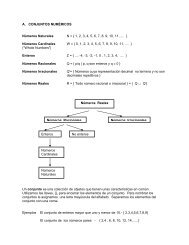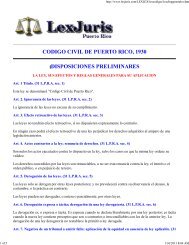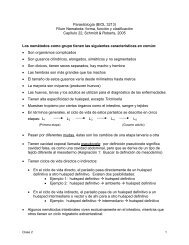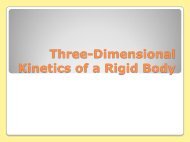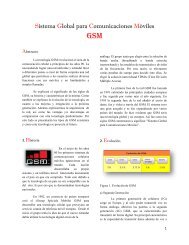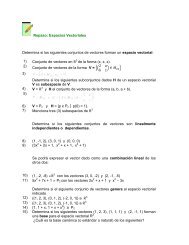BULK DEFORMATION PROCESSES Bulk Deformation Importance ...
BULK DEFORMATION PROCESSES Bulk Deformation Importance ...
BULK DEFORMATION PROCESSES Bulk Deformation Importance ...
You also want an ePaper? Increase the reach of your titles
YUMPU automatically turns print PDFs into web optimized ePapers that Google loves.
<strong>Bulk</strong> <strong>Deformation</strong> Processes in Metalworking1. Rolling<strong>BULK</strong> <strong>DEFORMATION</strong> <strong>PROCESSES</strong>2. Other <strong>Deformation</strong> Processes Related to Rolling3. ForgingMECN 4140 - Manufacturing ProcessesInter American University of Puerto RicoProf. Eduardo Cabrera Ruiz4. Other <strong>Deformation</strong> Processes Related to Forging5. Extrusion6. Wire and Bar DrawingBased on ©2007 John Wiley & Sons, Inc. M P Groover, Fundamentals of Modern Manufacturing 3/ePage 2<strong>Bulk</strong> <strong>Deformation</strong>Metal forming operations which cause significant shapechange by deforming metal parts whose initial form is bulkrather than sheet• Starting forms:– Cylindrical bars and billets,– Rectangular billets and slabs, and similar shapes• These processes stress metal sufficiently to cause plasticflow into desired shape• Performed as cold, warm, and hot working operations<strong>Importance</strong> of <strong>Bulk</strong> <strong>Deformation</strong>• In hot working, significant shape change can beaccomplished• In cold working, strength is increased during shapechange• Little or no waste - some operations are near net shape ornet shape processes– The parts require little or no subsequent machiningPage 3Page 4
Four Basic <strong>Bulk</strong> <strong>Deformation</strong> Processes1. Rolling – slab or plate is squeezed between opposing rollsRolling<strong>Deformation</strong> process in which work thickness is reduced by compressiveforces exerted by two opposing rolls2. Forging – work is squeezed and shaped between opposing dies3. Extrusion – work is squeezed through a die opening, thereby takingthe shape of the opening4. Wire and bar drawing – diameter of wire or bar is reduced bypulling it through a die openingFigure 19.1 The rollingprocess (specifically, flatrolling).Rotating rolls perform two main functions:• Pull the work into the gap between them by friction between workpartand rolls• Simultaneously squeeze the work to reduce its cross sectionPage 5Page 6Types of RollingRolled Products Made of Steel• Based on workpiece geometry :– Flat rolling - used to reduce thickness of a rectangularcross section– Shape rolling - square cross section is formed into ashape such as an I-beam• Based on work temperature :– Hot Rolling – most common due to the large amountof deformation required– Cold rolling – produces finished sheet and plate stockFigure 19.2 Some of the steel products made in a rolling mill.Page 7
Diagram of Flat RollingFigure 19.3 Side view of flat rolling,indicating before and after thicknesses, workvelocities, angle of contact with rolls, andother features.Draft = amount of thickness reductiond t twhere d = draft; t o = starting thickness;and t f = final thicknessReduction = draft expressed as a fraction ofstarting stock thickness:rodtowhere r = reductionfShape RollingWork is deformed into a contoured cross section rather thanflat (rectangular)• Accomplished by passing work through rolls that have thereverse of desired shape• Products include:– Construction shapes such as I-beams, L-beams, andU-channels– Rails for railroad tracks– Round and square bars and rodsPage 10Rolling MillsA rolling mill for hotflat rolling. The steelplate is seen as theglowing strip in lowerleft corner (photocourtesy of BethlehemSteel).• Equipment is massive and expensive• Rolling mill configurations:– Two-high – two opposing rolls– Three-high – work passes through rolls in bothdirections– Four-high – backing rolls support smaller work rolls– Cluster mill – multiple backing rolls on smaller rolls– Tandem rolling mill – sequence of two-high millsPage 11Page 12
Two-High Rolling MillThree-High Rolling MillFigure 19.5 Various configurations of rolling mills: (a) 2-high rollingmill.Figure 19.5 Various configurations of rolling mills: (b) 3-high rollingmill.Four-High Rolling MillCluster MillMultiple backing rolls allow even smaller roll diametersFigure 19.5 Various configurations of rolling mills: (c) four-high rolling mill.Figure 19.5 Various configurations of rolling mills: (d) cluster millPage 16
Tandem Rolling MillA series of rolling stands in sequenceFigure 19.5 Various configurations of rolling mills: (e) tandem rolling mill.Thread Rolling<strong>Bulk</strong> deformation process used to form threads on cylindricalparts by rolling them between two dies• Important commercial process for mass producing boltsand screws• Performed by cold working in thread rolling machines• Advantages over thread cutting (machining):– Higher production rates– Better material utilization– Stronger threads and better fatigue resistance due towork hardeningPage 17Page 18Thread RollingFigure 19.6 Thread rolling with flat dies: (1) start of cycle, and (2) end of cycle.Ring Rolling<strong>Deformation</strong> process in which a thick-walled ring of smallerdiameter is rolled into a thin-walled ring of larger diameter• As thick-walled ring is compressed, deformed metalelongates, causing diameter of ring to be enlarged• Hot working process for large rings and cold workingprocess for smaller rings• Applications: ball and roller bearing races, steel tires forrailroad wheels, and rings for pipes, pressure vessels, androtating machinery• Advantages: material savings, ideal grain orientation,strengthening through cold workingPage 20
Ring RollingFigure 19.7 Ring rolling used to reduce the wall thickness and increase thediameter of a ring: (1) start, and (2) completion of process.Forging<strong>Deformation</strong> process in which work is compressed betweentwo dies• Oldest of the metal forming operations, dating from about5000 B C• Components: engine crankshafts, connecting rods, gears,aircraft structural components, jet engine turbine parts• Also, basic metals industries use forging to establish basicform of large parts that are subsequently machined to finalshape and sizePage 22Classification of Forging Operations• Cold vs. hot forging:– Hot or warm forging – most common, due to thesignificant deformation and the need to reduce strengthand increase ductility of work metal– Cold forging – advantage: increased strength thatresults from strain hardening• Impact vs. press forging:– Forge hammer - applies an impact load– Forge press - applies gradual pressureTypes of Forging Dies• Open-die forging - work is compressed between two flatdies, allowing metal to flow laterally with minimumconstraint• Impression-die forging - die contains cavity or impressionthat is imparted to workpart– Metal flow is constrained so that flash is created• Flashless forging - workpart is completely constrained indie– No excess flash is createdPage 23Page 24
Open-Die ForgingImpression-Die ForgingFigure 19.9 Three types of forging: (a) open-die forging.Figure 19.9 Three types of forging: (b) impression-die forging.Flashless ForgingOpen-Die ForgingCompression of workpart between two flat dies• Similar to compression test when workpart has cylindricalcross section and is compressed along its axis– <strong>Deformation</strong> operation reduces height and increasesdiameter of work– Common names include upsetting or upset forgingFigure 19.9 Three types of forging (c) flashless forging.Page 28
Open-Die Forging with No FrictionIf no friction occurs between work and die surfaces, then homogeneousdeformation occurs, so that radial flow is uniform throughout workpartheight and true strain is given by:hln ohwhere h o = starting height; and h = height at some point duringcompression• At h = final value h f , true strain is maximum valueOpen-Die Forging with Friction• Friction between work and die surfaces constrains lateralflow of work, resulting in barreling effect• In hot open-die forging, effect is even more pronounceddue to heat transfer at and near die surfaces, which coolsthe metal and increases its resistance to deformationPage 29Figure 19.10 Homogeneousdeformation of a cylindricalworkpart under ideal conditionsin an open-die forging operation:(1) start of process withworkpiece at its original lengthand diameter, (2) partialcompression, and (3) final size.Figure 19.11 Actual deformation of a cylindrical workpart in open-die forging,showing pronounced barreling: (1) start of process, (2) partial deformation, and(3) final shape.Page 30Impression-Die ForgingCompression of workpart by dies with inverse of desired partshape• Flash is formed by metal that flows beyond die cavity intosmall gap between die plates• Flash must be later trimmed, but it serves an importantfunction during compression:– As flash forms, friction resists continued metal flow intogap, constraining material to fill die cavity– In hot forging, metal flow is further restricted by coolingagainst die platesImpression-Die ForgingFigure 19.14 Sequence in impression-die forging: (1) just prior to initial contactwith raw workpiece, (2) partial compression, and (3) final die closure,causing flash to form in gap between die plates.Page 31
Impression-Die Forging Practice• Several forming steps often required, with separate diecavities for each step– Beginning steps redistribute metal for more uniformdeformation and desired metallurgical structure insubsequent steps– Final steps bring the part to final geometry• Impression-die forging is often performed manually byskilled operator under adverse conditionsAdvantages and Limitations• Advantages of impression-die forging compared tomachining from solid stock:– Higher production rates– Less waste of metal– Greater strength– Favorable grain orientation in the metal• Limitations:– Not capable of close tolerances– Machining often required to achieve accuracies andfeatures neededPage 33Page 34Flashless ForgingFlashless ForgingCompression of work in punch and die tooling whose cavitydoes not allow for flash• Starting workpart volume must equal die cavity volumewithin very close tolerance• Process control more demanding than impression-dieforging• Best suited to part geometries that are simple andsymmetrical• Often classified as a precision forging processFigure 19.17 Flashless forging: (1) just before initial contact withworkpiece, (2) partial compression, and (3) final punch and die closure.Page 35
Forging Hammers (Drop Hammers)Apply impact load against workpart• Two types:– Gravity drop hammers - impact energy from fallingweight of a heavy ram– Power drop hammers - accelerate the ram bypressurized air or steam• Disadvantage: impact energy transmitted through anvilinto floor of building• Commonly used for impression-die forgingFigure 19.19 Drop forging hammer, fed by conveyor and heating units atthe right of the scene (photo courtesy of Chambersburg EngineeringCompany).Page 37Drop Hammer DetailsForging Presses• Apply gradual pressure to accomplish compressionoperation• Types:– Mechanical press - converts rotation of drive motor intolinear motion of ram– Hydraulic press - hydraulic piston actuates ramFigure 19.20 Diagram showing details of a drop hammer for impression-dieforging.– Screw press - screw mechanism drives ramPage 40
SwagingTrimmingCutting operation to remove flash from workpart inimpression-die forging• Usually done while work is still hot, so a separate trimmingpress is included at the forging station• Trimming can also be done by alternative methods, suchFigure 19.24 Swaging process to reduce solid rod stock; the dies rotateas they hammer the work In radial forging, the workpiece rotates whilethe dies remain in a fixed orientation as they hammer the work.as grinding or sawingPage 46Trimming After Impression-Die ForgingExtrusionCompression forming process in which work metal is forcedto flow through a die opening to produce a desiredcross-sectional shape• Process is similar to squeezing toothpaste out of atoothpaste tube• In general, extrusion is used to produce long parts ofuniform cross sections• Two basic types:– Direct extrusionFigure 19.29 Trimming operation (shearing process) to remove the flash afterimpression-die forging.– Indirect extrusionPage 48
Direct ExtrusionHollow and Semi-Hollow ShapesFigure 19.30 Direct extrusion.• Also called forward extrusion• As ram approaches die opening, a small portion of billetremains that cannot be forced through die opening• This extra portion, called the butt, must be separated fromextrudate by cutting it just beyond the die exit• Starting billet cross section usually round• Final shape of extrudate is determined by die openingFigure 19.31 (a) Direct extrusion to produce a hollow or semi-hollowcross sections; (b) hollow and (c) semi-hollow cross sections.Indirect ExtrusionAdvantages of Extrusion• Variety of shapes possible, especially in hot extrusion– Limitation: part cross section must be uniformthroughout length• Grain structure and strength enhanced in cold and warmFigure 19.32 Indirect extrusion to produce (a) a solid cross section and (b) a hollow cross section.• Also called backward extrusion and reverse extrusion• Limitations of indirect extrusion are imposed by– Lower rigidity of hollow ram– Difficulty in supporting extruded product as it exits dieextrusion• Close tolerances possible, especially in cold extrusion• In some operations, little or no waste of materialPage 52
Hot vs. Cold Extrusion• Hot extrusion - prior heating of billet to above itsrecrystallization temperature– Reduces strength and increases ductility of the metal,permitting more size reductions and more complexshapes• Cold extrusion - generally used to produce discrete parts– The term impact extrusion is used to indicate highspeed cold extrusionExtrusion RatioAlso called the reduction ratio, it is defined asrxAAwhere r x = extrusion ratio; A o = cross-sectional area of thestarting billet; and A f = final cross-sectional area of theextruded section• Applies to both direct and indirect extrusionofPage 53Page 54Extrusion Die FeaturesComments on Die Angle• Low die angle - surface area is large, which increasesfriction at die-billet interface– Higher friction results in larger ram force• Large die angle - more turbulence in metal flow duringreduction– Turbulence increases ram force required• Optimum angle depends on work material, billetFigure 19.35 (a) Definition of die angle in direct extrusion; (b) effect of die angleon ram force.temperature, and lubricationPage 56
Orifice Shape of Extrusion DieComplex Cross Section• Simplest cross section shape is circular die orifice• Shape of die orifice affects ram pressure• As cross section becomes more complex, higher pressureand greater force are required• Effect of cross-sectional shape on pressure can beassessed by means the die shape factor K xFigure 19.36 A complex extruded cross section for a heat sink (photocourtesy of Aluminum Company of America)Page 57Extrusion Presses• Either horizontal or vertical– Horizontal more common• Extrusion presses - usually hydraulically driven, which isespecially suited to semi-continuous direct extrusion oflong sections• Mechanical drives - often used for cold extrusion ofindividual partsWire and Bar DrawingCross-section of a bar, rod, or wire is reduced by pulling itthrough a die opening• Similar to extrusion except work is pulled through die indrawing (it is pushed through in extrusion)• Although drawing applies tensile stress, compression alsoplays a significant role since metal is squeezed as it passesthrough die openingPage 59Page 60
Wire and Bar DrawingWire Drawing vs. Bar Drawing• Difference between bar drawing and wire drawing is stocksize– Bar drawing - large diameter bar and rod stockFigure 19.40 Drawing of bar, rod, or wire.Area Reduction - Change in size of work is usually given byarea reduction:r Ao AAwhere r = area reduction in drawing; A o = original area ofwork; and A r = final workof– Wire drawing - small diameter stock - wire sizes downto 0.03 mm (0.001 in.) are possible• Although the mechanics are the same, the methods,equipment, and even terminology are differentPage 62Drawing Practice and Products• Drawing practice:– Usually performed as cold working– Most frequently used for round cross sections• Products:– Wire: electrical wire; wire stock for fences, coathangers, and shopping carts– Rod stock for nails, screws, rivets, and springs– Bar stock: metal bars for machining, forging, and otherprocessesBar Drawing• Accomplished as a single-draft operation - the stock ispulled through one die opening• Beginning stock has large diameter and is a straightcylinder• Requires a batch type operationFigure 19.41 Hydraulically operated draw bench for drawing metal bars.Page 63Page 64
Wire Drawing• Continuous drawing machines consisting of multiple draw dies(typically 4 to 12) separated by accumulating drums– Each drum (capstan) provides proper force to draw wire stockthrough upstream die– Each die provides a small reduction, so desired total reduction isachieved by the series– Annealing sometimes required between dies to relieve workhardeningFeatures of a Draw Die• Entry region - funnels lubricant into the die to prevent scoring ofwork and die• Approach - cone-shaped region where drawing occurs• Bearing surface - determines final stock size• Back relief - exit zone - provided with a back relief angle (half-angle)of about 30• Die materials: tool steels or cemented carbidesPage 65Figure 19.42 Continuous drawing of wire.Page 66Figure 19.43 Draw die for drawing of round rod or wire.Preparation of Work for Drawing• Annealing – to increase ductility of stock• Cleaning - to prevent damage to work surface and drawdie• Pointing – to reduce diameter of starting end to allowinsertion through draw dieEnd Lecture 10Lecture 11Page 67 Page 68






